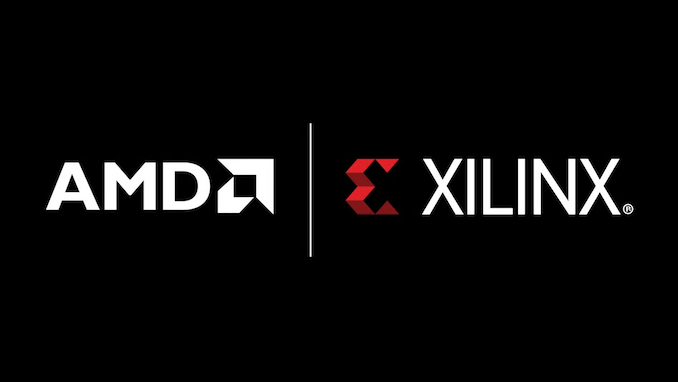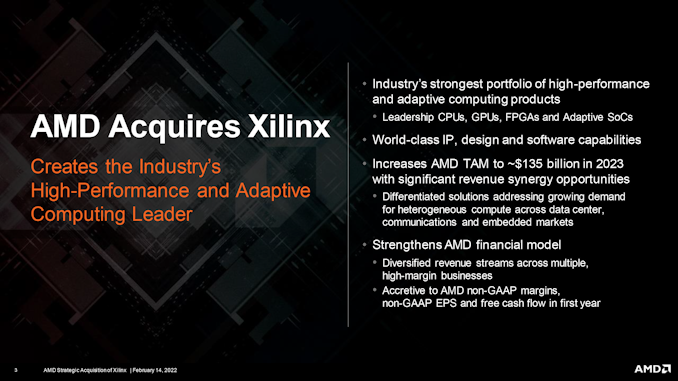Update: AMD’s Acquisition of Xilinx Receives Regulatory Go, Deal Closes At $49B
by Ryan Smith on February 14, 2022 9:30 AM EST
Update 02/14: AMD has sent out a brief statement this morning announcing that the Xilinx deal has formally closed. AMD has now fully acquired Xilinx. The final value of the deal, based on AMD's stock price at the closing, was $49B. Which according to AMD is the largest semiconductor acquisition in history.
Original Story, 02/10:
Although it’s taken a bit longer than planned, AMD’s acquisition of Xilinx has finally cleared the last regulatory hurdles. With the expiration of the mandatory HSR waiting period in the United States, AMD and Xilinx now have all of the necessary regulatory approval to close the deal, and AMD expects to complete its roughly $53 billion acquisition of the FPGA maker on or around February 14th, 2 business days from now.
Having previously received approval from Chinese regulators late last month, the final step in AMD’s acquisition of Xilinx has been waiting out the mandatory Hart-Scott-Rodino (HSR) Act waiting period, which gives US regulators time to review the deal, and take more action if necessary. That waiting period ended yesterday, February 9th, with no action taken by the US, meaning that the US will not be moving to block the deal, and giving AMD and Xilinx the green light to close on it.
With all the necessary approvals acquired, AMD and Xilinx are now moving quickly to finally consummate the acquisition. AMD expects to complete that process in two more business days, putting the closure of the deal on (or around) February 14th – which is fittingly enough Valentine’s Day.
16 months in the making, AMD’s acquisition of Xilinx is the biggest acquisition ever for the Texas-based company. The all-stock transaction was valued at $35 billion at the time the deal was announced, offering 1.7234 shares of AMD stock for each Xilinx share. Since then, AMD’s stock price has increased by almost 51% to $125/share, which will put the final price tag on the deal at close to $53 billion – which is almost a third of AMD’s entire market capitalization and underscores the importance of this deal to AMD. Once the deal closes, Xilinx’s current stockholders will find themselves owning roughly 26% of AMD, while AMD’s existing stockholders hold the remaining 74%.
Having rebounded from their darkest days last decade, AMD has since shifted into looking at how to further grow the company, both by increasing its market share in its traditional products like CPUs and GPUs, as well as by expanding into new markets entirely. In particular, AMD has turned its eye towards expanding their presence in the data center market, which has seen strong and sustained growth for virtually everyone involved.
With AMD’s recent growth in the enterprise space with its Zen-based EPYC processor lines, a natural evolution one might conclude would be synergizing high-performance compute with adaptable logic under one roof, which is precisely the conclusion that Intel also came to several years ago. To that end, the high-performance FPGA markets, as well as SmartNICs, adaptive SoCs, and other controllable logic driven by FPGAs represent a promising avenue for future growth for AMD – and one they were willing to pay significantly for.
Overall, this marks the second major industry acquisition to be resolved this week. While NVIDIA’s takeover of Arm was shut down, AMD’s acquisition of Xilinx will close out the week on a happier ending. Ultimately, both deals underscore just how lucrative the market is for data center-class processors, and to what lengths chipmakers will go to secure a piece of that growing market.
Source: AMD IR











34 Comments
View All Comments
mode_13h - Saturday, February 12, 2022 - link
You mean PhysX? Nvidia just turned that into software that runs on their GPUs.As for AI, that works quite well on GPUs, especially ones with Tensor cores. And compression/decompression is a hardware block in GPUs.
Qasar - Saturday, February 12, 2022 - link
yep, still i think it kind of proved that an and in card for a specific gaming task, isnt going to work, mostly cause of the lack of PCIe lanes on the desktop. i have to run my 1060 @ 8x, because i also have a m.2 card with 2 m.2 drives in it, and there just isnt enough PCIe to go around. i have been considering going back to 2 sata ssds that the 2 m.2 drives replaced cause of the PCIe lane allocation.i really wish, and hope that maybe AM5 increases the lanes, 40 lanes total, or at least an option on a higher end board would happen..... looks like intel has no interest in more lanes like x99 had any more
mode_13h - Saturday, February 12, 2022 - link
For a FPGA to pack enough horsepower to be interesting, it has to be pretty big. And that gets expensive, fast. Otherwise, it's limited to things like simple data transformations and implementing new crypto algorithms.Also, an FPGA can't touch the performance of dedicated hardware. So, if you want deep learning performance, put a NPU block in there. If you want graphics, put a GPU block. If you tried to do these functions with a FPGA, it would have to be far bigger than both, to have the same performance of either.
Yeah, FPGAs can do video compression, but I'm a bit skeptical it's going to be a huge win for something like AV1 over a split CPU/GPU software implementation, and definitely not as small or power-efficient as dedicated hardware.
Zoolook - Monday, February 14, 2022 - link
A 1060 doesn't need more than 8 lanes anyway, esp if it's pci-e 4.